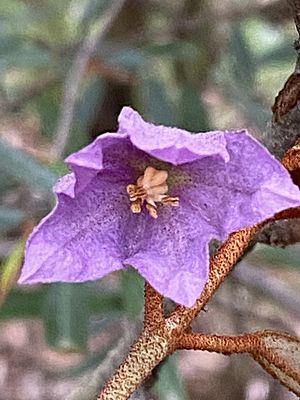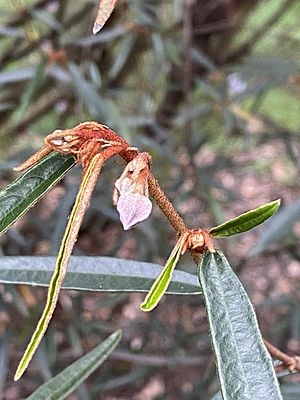Narrow-leaved thomasia facts for kids
Quick facts for kids Narrow-leaved thomasia |
|
|---|---|
 |
|
| Scientific classification | |
| Genus: |
Thomasia
|
| Species: |
angustifolia
|
Thomasia angustifolia, also known as the narrow-leaved thomasia, is a special plant that only grows in the south-west part of Western Australia. It has pretty pinkish-purple, bell-shaped flowers that hang down from where the leaves meet the stem.
What Does the Narrow-leaved Thomasia Look Like?
The narrow-leaved thomasia is a small shrub that usually grows to about 0.6 meters (2 feet) tall. It can spread out to about 1.2 meters (4 feet) wide. Its leaves are a dark green color. They are usually between 8 and 25 millimeters (about 0.3 to 1 inch) long. The leaves are also quite narrow, about 2 to 6 millimeters (0.08 to 0.24 inches) wide.
The edges of the leaves are smooth. If you look closely, you might see tiny, star-shaped hairs covering the leaf surface. Young leaves have a small part called a stipule at their base. This stipule is about 5 to 6 millimeters long, but it falls off quickly as the leaf gets older.
The flowers have two small petals that look like tiny lobes. These are found near the plant's ovary, which is where seeds will form. The main part of the flower is made of pink or purple sepals. These sepals are like small leaves that protect the flower bud. They are about 3.5 to 7 millimeters long and are joined together about halfway up. They are also covered in those tiny star-shaped hairs.
Below these main sepals, there are even smaller ones. These are about 5.5 to 8 millimeters long and are also covered in star-shaped hairs, but they are not joined together. The flower hangs from a small stem called a pedicel. This pedicel is about 4 to 6.5 millimeters long and has star-shaped hairs too. The inner part of the flower, called the corolla, is smooth and very small, only about 0.7 to 2 millimeters long. You can see these beautiful flowers from late autumn all the way through to late spring.
How Did the Narrow-leaved Thomasia Get Its Name?
The narrow-leaved thomasia was first officially described in 1845. A botanist named Ernst Gottlieb von Steudel wrote about it in a book called Plantae Preissianae.
The second part of its scientific name, angustifolia, tells us something special about the plant. It comes from two Latin words:
- angustus means "narrow"
- folium means "leaf"
So, angustifolia literally means "narrow-leaved," which perfectly describes this plant!
Where Does the Narrow-leaved Thomasia Grow?
The narrow-leaved thomasia grows in the south-west of Western Australia. You can find it in different types of soil. It likes sandy plains and also areas with loam, which is a mix of sand, silt, and clay. Sometimes, it even grows in damp spots near small creeks. It is found in an area stretching from Albany in the west to Esperance in the east.


